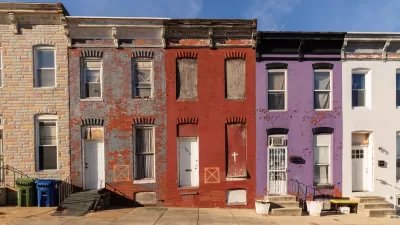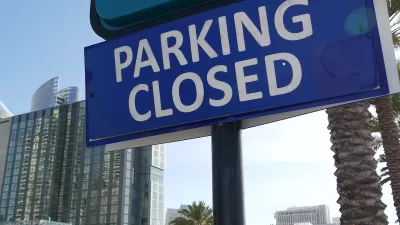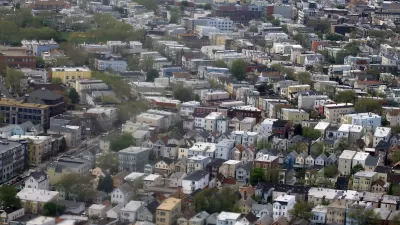Every city has blight – the unsightly, derelict, abandoned, disheveled, and under-utilized spaces of our urban areas. It drains the life out of neighborhoods, drives down the values of surrounding properties, and just looks really bad. So what do cities do about it? Some seize it through eminent domain for redevelopment and others offer incentives to developers to replace it with something better. Many of them, though, don’t do anything at all. But removing blight from a city is not impossible, and it doesn’t have to be an elaborate multi-party scheme or a drawn-out political process. It can be as simple as a coat of paint.
Every city has blight – the unsightly, derelict, abandoned, disheveled, and under-utilized spaces of our urban areas. It drains the life out of neighborhoods, drives down the values of surrounding properties, and just looks really bad. So what do cities do about it? Some seize it through eminent domain for redevelopment and others offer incentives to developers to replace it with something better. Many of them, though, don't do anything at all. But removing blight from a city is not impossible, and it doesn't have to be an elaborate multi-party scheme or a drawn-out political process. It can be as simple as a coat of paint.
In most cases blighted properties are left to rot on their own, below the eyesight of city officials and politicians. But blight out of sight is still blight in the end, and it is a situation that not only feeds on itself, but feeds on its surroundings. Stopping the blight monster from swallowing up entire neighborhoods does require effort, but maybe not as much as some would think.
The borough of Delfshaven in Rotterdam had the very simple idea that if blighted areas were more noticeable they would be more likely to attract the attention of neighbors and the movers and shakers capable of taking the action to remedy them. So they contacted local artist Florentijn Hofman to come up with an idea to make a one blighted and derelict block of the borough more noticeable. Hofman's solution was a new coat of paint – bright sky blue, over the entire building; windows, roofs and all.

The idea was to keep the building in its bright blue state until there was a viable plan to renew or revive the blighted area. And almost instantly, what was once an overlooked and easily ignorable area became one of the most seen places in the city. As Hofman's website describes, "By redecorating this block, which was built in the first years of the 20th century, people start looking again at what was and is there, and maybe think about what they will get in return."

This blue building not only brings people's attention back to a once-forgotten space, but also works to prod the development (or redevelopment) community to take advantage of the existing opportunities in the city. Having a bright blue building screaming at your face every day – whether you're a developer, a planner or a neighbor – would most likely motivate you to see about getting something done.
Other cities should learn from this example, and should start to rethink how they handle (or don't handle) their blighted areas. By creating a situation that is at once a call to action, an unavoidable reminder, and even a tourist attraction, cities can better realize the potential of the blighted spaces they might have otherwise continued to disregard.
UPDATE: Florentijn Hofman recently contacted me to add a little more clarity to this blog post. From Hofman:
"The borough of Delfshaven in Rotterdam asked me to do a wall they wanted to put there to cover the doors of the derelict block. They had the notion of graffiti, and asked me to make a mural with a local graffiti artist. I said 'No!' and came up with this idea. The moral of the story is they wanted to make the area more nice but with an ancient method (graffiti) -- as if that always works. It's a tool they knew. I've given them another tool -- paint the whole block! Now I see it done more and more often in other boroughs of the city."

Manufactured Crisis: Losing the Nation’s Largest Source of Unsubsidized Affordable Housing
Manufactured housing communities have long been an affordable housing option for millions of people living in the U.S., but that affordability is disappearing rapidly. How did we get here?

Americans May Be Stuck — But Why?
Americans are moving a lot less than they once did, and that is a problem. While Yoni Applebaum, in his highly-publicized article Stuck, gets the reasons badly wrong, it's still important to ask: why are we moving so much less than before?

Research Shows More Roads = More Driving
A national study shows, once again, that increasing road supply induces additional vehicle travel, particularly over the long run.

Judge Halts Enforcement of Anti-Homeless Laws in Grants Pass
The Oregon city will be barred from enforcing two ordinances that prosecute unhoused residents until it increases capacity and accessibility at designated camping sites.

Advancing Sustainability in Los Angeles County Schools
The Los Angeles County Office of Education’s Green Schools Symposium brings together educators, students, and experts to advance sustainability in schools through innovative design, climate resilience strategies, and collaborative learning.

Using Old Oil and Gas Wells for Green Energy Storage
Penn State researchers have found that repurposing abandoned oil and gas wells for geothermal-assisted compressed-air energy storage can boost efficiency, reduce environmental risks, and support clean energy and job transitions.
Urban Design for Planners 1: Software Tools
This six-course series explores essential urban design concepts using open source software and equips planners with the tools they need to participate fully in the urban design process.
Planning for Universal Design
Learn the tools for implementing Universal Design in planning regulations.
City of Moreno Valley
Institute for Housing and Urban Development Studies (IHS)
City of Grandview
Harvard GSD Executive Education
NYU Wagner Graduate School of Public Service
City of Cambridge, Maryland
Newport County Development Council: Connect Greater Newport





























